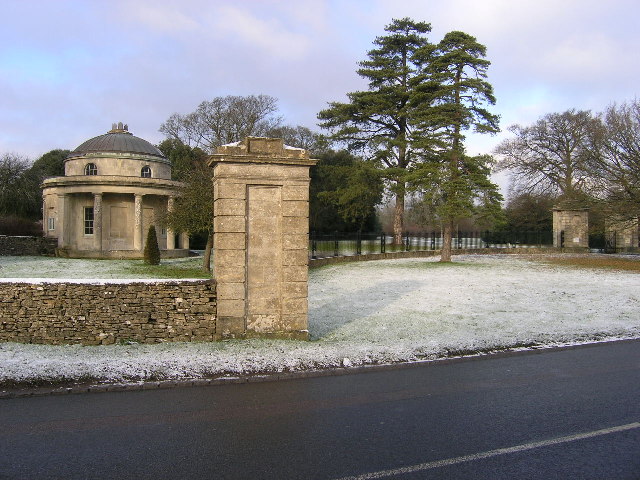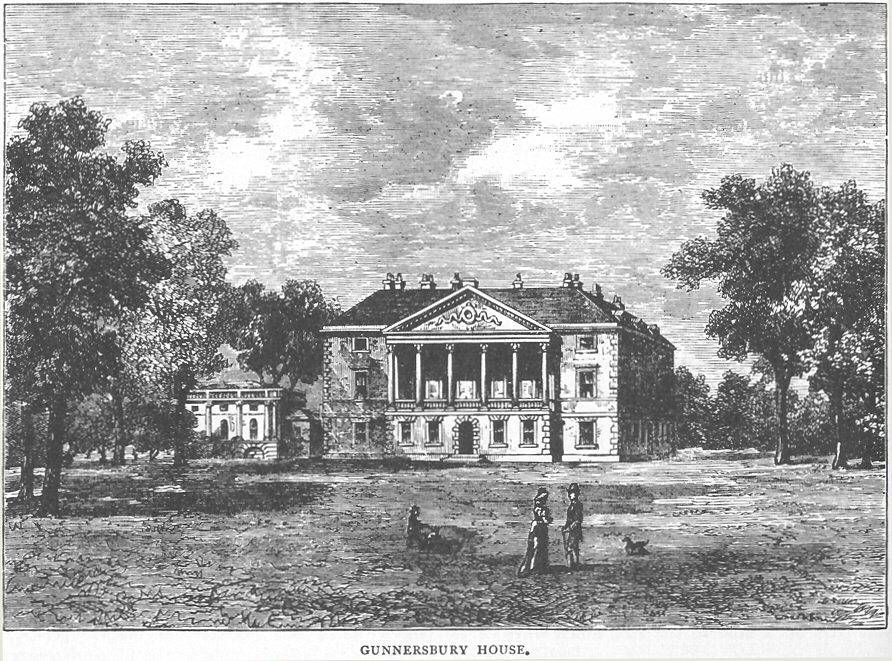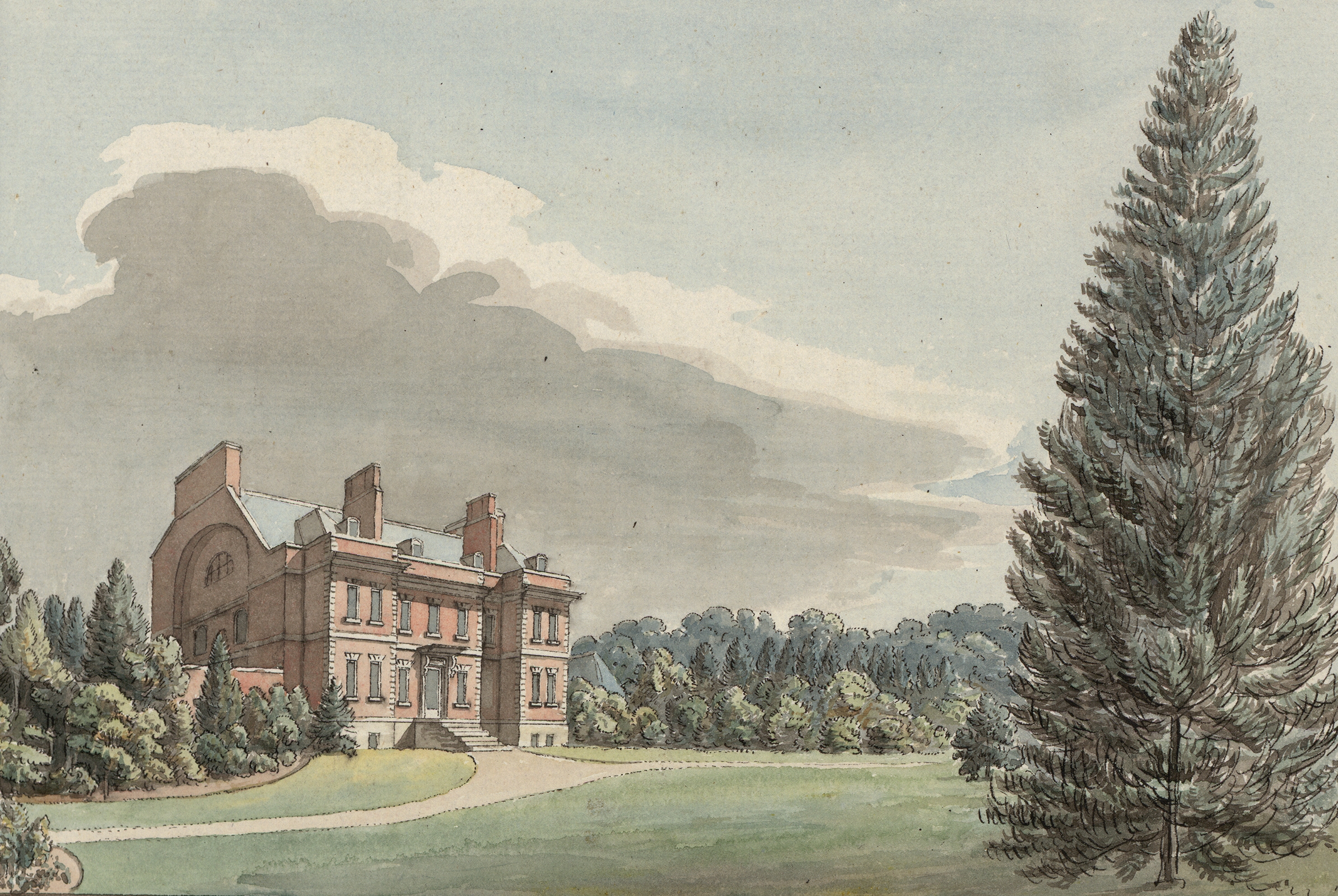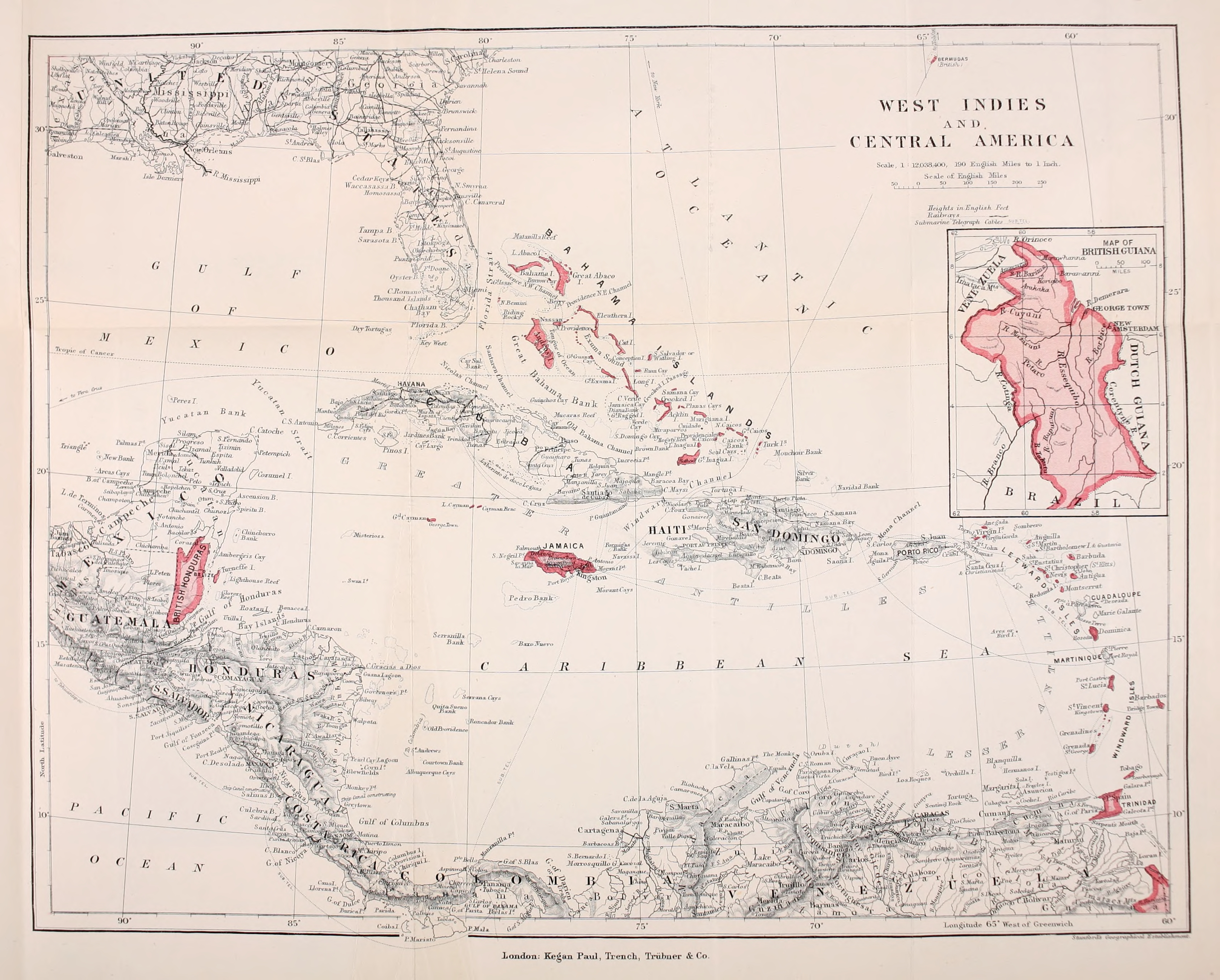|
Dodington Park
Dodington Park is a country house and estate in Dodington, South Gloucestershire, England. The house was built by James Wyatt for Christopher Bethell Codrington (of the Codrington baronets). The family had made their fortune from sugar plantations in the Caribbean and were significant owners of slaves. It remained in the Codrington family until 1980; it is now owned by the British businessman James Dyson. The estate comprises some 300 acres of landscaped park with woods, lakes, lodges, a dower house, an orangery, a church, and a walled kitchen garden. Formal gardens adjoin the main house. The house is Grade I listed on the National Heritage List for England and the landscaped park is Grade II* listed on the Register of Historic Parks and Gardens. The dower house, orangery, and St Mary's Church which all adjoin the house are also each individually Grade I listed, as is the Bath lodge at the southern part of the estate. The wall, railings and gate piers near the Bath lodge a ... [...More Info...] [...Related Items...] OR: [Wikipedia] [Google] [Baidu] |
Gloucestershire
Gloucestershire ( abbreviated Glos) is a county in South West England. The county comprises part of the Cotswold Hills, part of the flat fertile valley of the River Severn and the entire Forest of Dean. The county town is the city of Gloucester and other principal towns and villages include Cheltenham, Cirencester, Kingswood, Bradley Stoke, Stroud, Thornbury, Yate, Tewkesbury, Bishop's Cleeve, Churchdown, Brockworth, Winchcombe, Dursley, Cam, Berkeley, Wotton-under-Edge, Tetbury, Moreton-in-Marsh, Fairford, Lechlade, Northleach, Stow-on-the-Wold, Chipping Campden, Bourton-on-the-Water, Stonehouse, Nailsworth, Minchinhampton, Painswick, Winterbourne, Frampton Cotterell, Coleford, Cinderford, Lydney and Rodborough and Cainscross that are within Stroud's urban area. Gloucestershire borders Herefordshire to the north-west, Worcestershire to the north, Warwickshire to the north-east, Oxfordshire to the east, Wiltshire to the south, Bristol and Somerset ... [...More Info...] [...Related Items...] OR: [Wikipedia] [Google] [Baidu] |
Cotswolds
The Cotswolds (, ) is a region in central-southwest England, along a range of rolling hills that rise from the meadows of the upper Thames to an escarpment above the Severn Valley and Evesham Vale. The area is defined by the bedrock of Jurassic limestone that creates a type of grassland habitat rare in the UK and that is quarried for the golden-coloured Cotswold stone. The predominantly rural landscape contains stone-built villages, towns, and stately homes and gardens featuring the local stone. Designated as an Area of Outstanding Natural Beauty (AONB) in 1966, the Cotswolds covers making it the largest AONB. It is the third largest protected landscape in England after the Lake District and Yorkshire Dales national parks. Its boundaries are roughly across and long, stretching southwest from just south of Stratford-upon-Avon to just south of Bath near Radstock. It lies across the boundaries of several English counties; mainly Gloucestershire and Oxfordshire, and parts ... [...More Info...] [...Related Items...] OR: [Wikipedia] [Google] [Baidu] |
Francis Bernasconi
Francis Bernasconi (1762 – 1 January 1841), aka Francisco Bernasconi, was an English ornamental carver and plasterer of Italian descent. He became one of the most successful ornamental carvers and plasterers in Georgian Britain. Early life Francis Bernasconi was the son of Bartholomew (Bartolomeo) Bernasconi (died 1786), who hailed from a family of architects and stuccoists from the environs of Lugano, Switzerland. He is likely to have been related to the ornamental plasterer Bernardo or Bernato Bernasconi, "a poor man with a large fameley in the town of Buckingham". His more distant cousins of the same Lugano dynasty included various architects, sculptors and stuccatore active in Italy, Germany, Spain and Russia. Works *Gothic stucco work for Cobham Hall, Kent (1800–1809) *Stucco work in the Great Tower of Westminster Abbey (1803) *Mouldings, angels and heraldic shields in Windsor Castle (1805) *Interior plasterwork in Laurieston House, 51-2 Carlton Place, Glasgow (18 ... [...More Info...] [...Related Items...] OR: [Wikipedia] [Google] [Baidu] |
John Webb (architect)
John Webb (1611 – 24 October 1672) was an English architect and scholar, who collaborated on some works with Inigo Jones. Life He was born in Little Britain, Smithfield, London, and died in Butleigh in Somerset. He had a close association with fellow architect and theatre designer Inigo Jones, for whom he worked as an assistant from 1628.Giles Worsley, ''Inigo Jones and the European Classical Tradition'' (Yale, 2007), p. 177. In the 1640s and 1650s, Jones and Webb jointly designed Wilton House (near Salisbury, Wiltshire) with its distinctive Single and Double Cube rooms. Webb's earliest known drawings were made for the Barber Surgeons' Hall in London in 1636–7, and in 1638 he designed a lodge for John Penruddock at Hale in Hampshire and stables for a Mr Featherstone, but it is unclear if these were built. At the beginning of the Civil War, Jones left London to attend the King at Oxford. He was later in Basing House and captured at the end of the siege. Webb stayed in ... [...More Info...] [...Related Items...] OR: [Wikipedia] [Google] [Baidu] |
William Emes
William Emes (1729 or 1730–13 March 1803) was an English landscape gardener. Biography Details of his early life are not known but in 1756 he was appointed head gardener to Sir Nathaniel Curzon at Kedleston Hall, Derbyshire. He left this post in 1760 when Robert Adam was given responsibility for the entire management of the grounds. During his time at Kedleston he had started to alter the earlier formal nature of the park and had constructed the upper lake. Also during this time he married Mary Innocent, who was his servant and the daughter of a tailor. Together they had five sons and three daughters.Goodway, K "Emes, William (1729/30–1803)", rev., ''Oxford Dictionary of National Biography'', Oxford University Press, 2004accessed 30 January 2007/ref> His son John Emes who was born in 1762 was a successful engraver and silversmith. After leaving Kedleston he moved to live in Bowbridge House, (Not Bowbridge Fields farm as previously thought) Mackworth, Amber Valley, Mackwort ... [...More Info...] [...Related Items...] OR: [Wikipedia] [Google] [Baidu] |
Capability Brown
Lancelot Brown (born c. 1715–16, baptised 30 August 1716 – 6 February 1783), more commonly known as Capability Brown, was an English gardener and landscape architect, who remains the most famous figure in the history of the English landscape garden style. He is remembered as "the last of the great English 18th-century artists to be accorded his due" and "England's greatest gardener". Unlike other architects including William Kent, he was a hands-on gardener and provided his clients with a full turnkey service, designing the gardens and park, and then managing their landscaping and planting. He is most famous for the landscaped parks of English country houses, many of which have survived reasonably intact. However, he also included in his plans "pleasure gardens" with flower gardens and the new shrubberies, usually placed where they would not obstruct the views across the park of and from the main facades of the house. Few of his plantings of "pleasure gardens" have s ... [...More Info...] [...Related Items...] OR: [Wikipedia] [Google] [Baidu] |
History Of The British West Indies
The term British West Indies refers to the former English and British colonies and the present-day overseas territories of the United Kingdom in the Caribbean. In the history of the British West Indies there have been several attempts at political unions. These attempts have occurred over a period of more than 300 years, from 1627 to 1958, and were carried out, or sometimes imposed, first by the English and then the British government. During this time, some of the attempted unions were true federations of colonies and others involved attaching various colonies to a major nearby colony for the purposes of cheaper, efficient government or because the attached colonies were too small to justify a governor and administration of their own. The initial federal attempts never went so far as to try to encompass all of the British West Indies (BWI), but were more regional in scope. The historical regional groupings were the British Leeward Islands, the British Windward Islands, and Ja ... [...More Info...] [...Related Items...] OR: [Wikipedia] [Google] [Baidu] |
Sugar Plantations In The Caribbean
Sugar plantations in the Caribbean were a major part of the economy of the islands in the 18th, 19th, and 20th centuries. Most Caribbean, Caribbean islands were covered with Sugarcane, sugar cane fields and mills for refining the crop. The main source of labor, until Abolitionism, the abolition of chattel slavery, was Atlantic slave trade, enslaved Africans. After the abolition of slavery, Indentured servitude, indentured laborers from India, China, Portugal and other places were brought to the Caribbean to work in the sugar industry. These plantations produced 80 to 90 percent of the sugar consumed in Western Europe, later supplanted by European-grown sugar beet. The sugar trade Sugar cane development in the Americas The Portuguese introduced sugar plantations in the 1550s off the coast of their Brazilian settlement colony, located on the island Sao Vincente. As the Portuguese and Spanish maintained a strong colonial presence in the Caribbean, the Iberian Peninsula amassed t ... [...More Info...] [...Related Items...] OR: [Wikipedia] [Google] [Baidu] |
Elizabethan Architecture
Elizabethan architecture refers to buildings of a certain style constructed during the reign of Queen Elizabeth I of England and Ireland from 1558–1603. Historically, the era sits between the long era of the dominant architectural style of religious buildings by the Catholic Church, which ended abruptly at the Dissolution of the Monasteries from c.1536, and the advent of a court culture of pan-European artistic ambition under James I (1603–25). Stylistically, Elizabethan architecture is notably pluralistic. It came at the end of insular traditions in design and construction called the Perpendicular style in the church building, the fenestration, vaulting techniques, and open truss designs of which often affected the detail of larger domestic buildings. However, English design had become open to the influence of early printed architectural texts (namely Vitruvius and Alberti) imported to England by members of the church as early as the 1480s. Into the 16th century, illus ... [...More Info...] [...Related Items...] OR: [Wikipedia] [Google] [Baidu] |
Dodington House, Gloucestershire 1984 (geograph 5284347) ...
{{disambiguation ''Dodington'' may refer to: * Dodington, Gloucestershire, a village and civil parish in Gloucestershire, England * Dodington, Somerset, a village in Somerset, England * Dodington, a village in the parish of Whitchurch, Shropshire, England See also *Doddington (other) Doddington could refer to Places in England *Doddington, Cambridgeshire *Doddington, Cheshire *Doddington, Kent *Doddington, Lincolnshire *Doddington, Northumberland *Dry Doddington, Lincolnshire *Great Doddington Great Doddington is a village ... [...More Info...] [...Related Items...] OR: [Wikipedia] [Google] [Baidu] |
Chippenham
Chippenham is a market town A market town is a settlement most common in Europe that obtained by custom or royal charter, in the Middle Ages, a market right, which allowed it to host a regular market; this distinguished it from a village or city. In Britain, small rural ... in northwest Wiltshire, England. It lies northeast of Bath, Somerset, Bath, west of London, and is near the Cotswolds Area of Natural Beauty. The town was established on a crossing of the River Avon, Bristol, River Avon and some form of settlement is believed to have existed there since before Roman Britain, Roman times. It was a royal vill, and probably a royal hunting lodge, under Alfred the Great. The town continued to grow when the Great Western Railway arrived in 1841. The town had a population of 36,548 in 2021. Geography Location Chippenham is in western Wiltshire, at a prominent crossing of the River Avon (Bristol), River Avon, between the North Wessex Downs, Marlborough Downs to the east, t ... [...More Info...] [...Related Items...] OR: [Wikipedia] [Google] [Baidu] |
A432 Road , a chess opening (by ''Encyclopaedia of Chess Openings'' code)
{{Letter-NumberCombDisambig ...
A43 or A-43 may refer to: Military * Curtiss A-43 Blackhawk, an American prototype aircraft * Douglas A-43 Jetmaster, an American prototype aircraft * Black Prince (tank), an experimental British heavy tank * Advanced Landing Ground A-43, an airfield in France Roads * A43 road, a primary road in the English Midlands * A43 road (Northern Ireland), a primary road in Northern Ireland * A43 autoroute, a French highway * A 43, Bundesautobahn 43 in Germany Other uses * HLA-A43, an HLA-A serotype * Benoni Defense The Benoni Defense is a chess opening characterized by an early reply of ...c5 against White's opening move 1.d4. Most commonly, it is reached by the sequence: :1. b:Chess Opening Theory/1. d4, d4 b:Chess Opening Theory/1. d4/1...Nf6, Nf6 :2. b:Ch ... [...More Info...] [...Related Items...] OR: [Wikipedia] [Google] [Baidu] |






.jpg)
_cropped_2.jpg)
